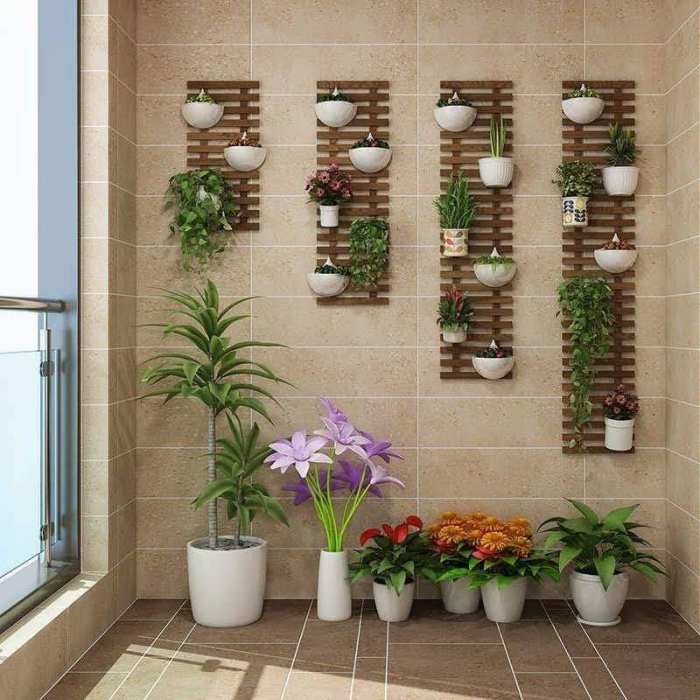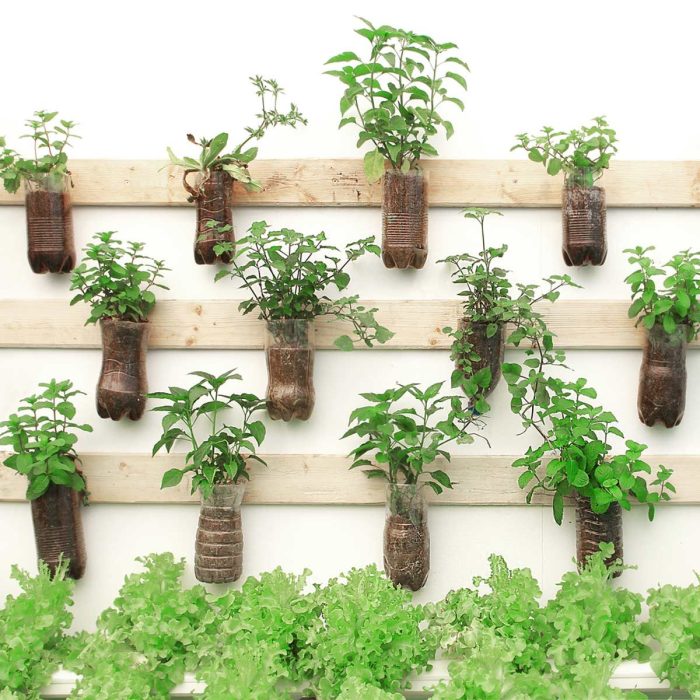10 hanging plants on wall – Hanging plants on wall are a popular way to add greenery and life to any indoor space. They can be used to create a vertical garden, add a touch of color, or simply bring the outdoors in. Whatever your reason for wanting to hang plants on your walls, there are plenty of options to choose from.
In this guide, we’ll discuss 10 of the most popular hanging plants for walls, as well as provide tips on how to choose the right plants for your space and how to care for them.
Hanging Plant Types

Hanging plants bring a touch of nature and elegance to indoor spaces, adding visual interest and improving air quality. With a wide variety of species to choose from, there’s a hanging plant to suit every environment and personal style.
Some popular hanging plants include:
Spider Plant
- Spider plants (Chlorophytum comosum) are easy-care plants that produce long, trailing stems with clusters of small, variegated leaves.
- They prefer bright, indirect light and moist soil, making them suitable for most indoor environments.
- Spider plants are also known for their ability to purify the air, removing toxins such as formaldehyde and xylene.
Pothos
- Pothos (Epipremnum aureum) is another low-maintenance hanging plant with heart-shaped leaves that come in a variety of colors, including green, yellow, and white.
- They can tolerate low light conditions and prefer moist soil, making them ideal for dimly lit spaces.
- Pothos is also known for its air-purifying abilities, removing toxins such as benzene and trichloroethylene.
String of Pearls
- String of pearls (Senecio rowleyanus) is a unique hanging plant with trailing stems adorned with small, bead-like leaves that resemble pearls.
- They prefer bright, indirect light and well-draining soil, making them suitable for sunny windows or porches.
- String of pearls is relatively drought-tolerant and does not require frequent watering.
Wall Mounting Options

Hanging plants on walls adds vertical greenery and brings life to indoor spaces. Selecting the appropriate wall mounting method is crucial to ensure plant stability and prevent damage to walls.
Wall mounting options vary based on plant size, weight, and wall material. Here are some common methods:
Brackets
- Brackets are L-shaped or Z-shaped metal or plastic supports that provide a sturdy base for hanging plants.
- They are suitable for heavier plants and can be mounted on drywall, plaster, or brick walls using screws or anchors.
- Brackets offer flexibility in adjusting plant height and can accommodate multiple plants on a single bracket.
Hooks
- Hooks are simple and versatile mounting options for lightweight plants.
- They can be screwed into walls or attached to adhesive strips for easy installation.
- Hooks are ideal for hanging small pots or trailing plants and can be used in combination with macrame or wire hangers for a decorative touch.
Shelves
- Shelves provide a stable surface for displaying multiple plants at varying heights.
- They can be mounted on walls using brackets or anchors and can accommodate pots of different sizes and shapes.
- Shelves are suitable for larger plants or those that require ample sunlight, as they can be positioned at an optimal distance from windows.
Design Considerations
Vertical gardening with hanging plants offers a creative and space-saving approach to indoor design. By understanding the principles of vertical gardening, homeowners can effectively incorporate hanging plants into their room’s design, creating a lush and visually appealing living space.
Hanging plants on walls can add a touch of greenery and freshness to any room. For bathrooms, certain plants are particularly well-suited due to their ability to thrive in humid environments. 10 hanging plants good for bathroom include spider plants, ferns, and air plants, which can help purify the air and create a relaxing atmosphere.
These plants are easy to care for and can add a touch of nature to any bathroom, making it a more inviting and enjoyable space.
When choosing plant placement, consider the room’s overall layout, natural light sources, and the size and shape of the hanging plants. Spacing is crucial to ensure adequate air circulation and prevent overcrowding. Experiment with different heights and positions to create a dynamic and visually interesting display.
A touch of greenery can transform any indoor space, and hanging plants are a great way to add a vertical element to your décor. Whether you’re looking for a trailing plant to cascade down a wall or a lush fern to brighten up a corner, there are plenty of options to choose from.
For more inspiration, check out our guide to 10 hanging plants indoor . You’ll find a variety of plants that are perfect for hanging on walls, from the easy-care pothos to the dramatic spider plant.
Color Combinations, 10 hanging plants on wall
Color plays a significant role in creating a cohesive and aesthetically pleasing arrangement. Consider the color scheme of the room and choose plants with foliage and blooms that complement or contrast with the existing décor. Warm colors, such as reds and oranges, can add a touch of vibrancy, while cool colors, like blues and greens, evoke a sense of tranquility.
Monochromatic schemes, featuring plants with varying shades of the same color, create a sophisticated and elegant look. Alternatively, complementary colors, such as green and red or blue and orange, can create a striking and eye-catching display.
DIY Projects and Tutorials
For those who relish in the thrill of crafting and personalization, DIY projects offer an unparalleled opportunity to create custom hanging planters that perfectly complement their aesthetic sensibilities and spatial constraints.
Hanging plants can add a touch of greenery and life to any room, and they’re a great way to make use of vertical space. If you’re looking for some inspiration for your own hanging plant display, check out 10 hanging plants melbourne . This website features a variety of hanging plants that are perfect for any home, from small apartments to large houses.
Whether you’re looking for a trailing plant to add some drama to your living room or a flowering plant to brighten up your kitchen, you’re sure to find something you love on this website. Once you’ve chosen your plants, be sure to hang them in a spot where they’ll get plenty of sunlight and water.
With a little care and attention, your hanging plants will thrive and add beauty to your home for years to come.
Macrame Plant Hangers
Macrame, an ancient art form involving intricate knotting techniques, has gained renewed popularity in recent times. With its versatility and aesthetic appeal, macrame is an ideal medium for crafting unique hanging planters.
- Materials:Macrame cord, wooden beads (optional), scissors, measuring tape
- Steps:
- Cut cords to desired lengths and gather them together at the top.
- Create a series of square knots or other macrame patterns.
- Insert wooden beads for added embellishment (optional).
- Secure the cords at the bottom with a lark’s head knot or other suitable method.
Maintenance and Care

Maintaining the health and beauty of hanging plants requires proper care. This includes watering, fertilizing, and pruning, tailored to the specific needs of each plant species.
Watering is crucial for hydration, but overwatering can lead to root rot. Allow the soil to dry out slightly between waterings and adjust the frequency based on the plant’s needs and the environment.
Fertilizing
Fertilizing provides essential nutrients for plant growth. Use a balanced fertilizer diluted to half strength and apply it during the growing season. Avoid over-fertilizing, as it can burn the roots.
Pruning
Pruning removes dead or overgrown stems, encourages bushier growth, and improves airflow. Use sharp, clean shears and make cuts at a 45-degree angle to promote new growth.
Troubleshooting
Common problems with hanging plants include yellowing leaves, stunted growth, and pests. Yellowing leaves may indicate overwatering, underwatering, or nutrient deficiency. Stunted growth can be caused by insufficient light or improper fertilization. Pests can be treated with insecticidal soap or neem oil.
Closure: 10 Hanging Plants On Wall

Hanging plants are a great way to add beauty and life to any room. They can be used to create a variety of looks, from lush and tropical to modern and minimalist. With so many different plants to choose from, you’re sure to find the perfect ones to complement your home décor.
Popular Questions
What are the most popular hanging plants?
Some of the most popular hanging plants include pothos, spider plants, philodendrons, and ferns.
How do I choose the right hanging plants for my space?
When choosing hanging plants for your space, consider the amount of light the area receives, the size of the plants, and the overall style of your décor.
How do I care for hanging plants?
Hanging plants typically require more frequent watering than other plants, as they are more exposed to the air and can dry out more quickly. They also need to be fertilized regularly and pruned to keep them looking their best.